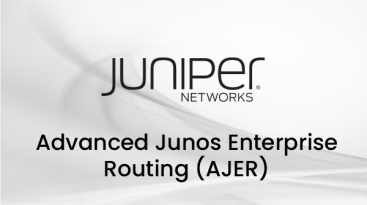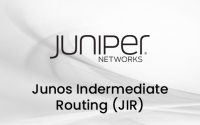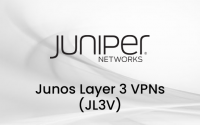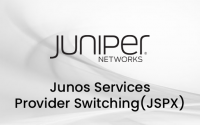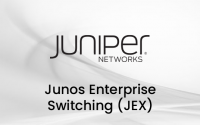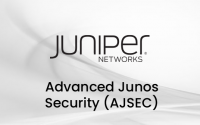Overview
This course is designed to provide students with the tools required for implementing, monitoring, and troubleshooting Layer 3 components in an enterprise network. Detailed coverage of OSPF, BGP, multicast, class of service (CoS), and EVPN-VXLAN is covered in depth. The course also exposes students to common troubleshooting commands and tools used to troubleshoot various intermediate to advanced issues.
Duration 5 days.
You can find current trainings on training calendar page.
Training Prerequisites
Students should have basic networking knowledge and an understanding of the Open Systems Interconnection (OSI) model and the TCP/IP protocol suite. Students should also have working experience with basic routing principles. Students should also attend the Introduction to the Junos Operating System (IJOS) and Junos Intermediate Routing (JIR) courses prior to attending this class.
Training Contents
Course Introduction
OSPF
- OSPFv2 Review
- Link-State Advertisements
- Protocol Operations
- OSPF Authentication
- OSPFv3
OSPF Areas
- Review of OSPF Areas
- Stub Area Operation
- Stub Area Configuration
- NSSA Operation
- NSSA Configuration
- Route Summarization
Advanced OSPF Options
- OSPF Multi-Area Adjacencies
- Virtual Links
- External Reachability
Troubleshooting OSPF
- Troubleshooting OSPF Adjacency Issues
- Troubleshooting LSDB Consistency Issues
- Case Study: Adjacency Issues
BGP
- Review of BGP
- BGP Configuration Options
- BGP Operations
- BGP Path Selection and Options
BGP Attributes and Policy
- Policy and BGP
- BGP Attributes
- Details and Manipulation of Common BGP Attributes
Troubleshooting BGP
- BGP Troubleshooting
- BGP Case Study
Enterprise Routing Policies
- Enterprise BGP Core Network Design
- Enterprise External Network Deployment
Troubleshooting Policies
- Routing Policy Overview
- Routing Policy Structure
- Using RegEx
- Routing Policy Troubleshooting
- Case Study
Introduction to Multicast
- Overview of Multicast
- Multicast Addressing
- RPF
- IGMP
Multicast Routing Protocols and SSM
- Overview of Multicast Routing Protocols
- PIM-SM Using the ASM Model
- PIM-SM Using the SSM Model
Troubleshooting Multicast
- Multicast Troubleshooting
- Multicast Case Study
Class of Service
- CoS Components Review and Case Study
- CoS Processing and CoS Defaults on the SRX Series Device
- Policing
- Virtual Channels
- Monitoring with Resource Performance Monitoring
Troubleshooting Class of Service
- CoS Troubleshooting
- CoS Case Study
Enterprise Architectures
- Traditional Enterprise Networks
- A New Architecture
- Key Concepts of the Evolved Core
- IP Fabric Campus Design
VXLAN
- Layer 2 Connectivity over a Layer 3 Network
- VXLAN Overview
- VXLAN Gateways
EVPN-VXLAN
- Overview of EVPN
- EVPN Operations
- EVPN and VXLAN
Configuring EVPN-VXLAN
- EVPN-VXLAN Spine Only Network
- IP Fabric Leaf Nodes in a Spine Only Design
- A New IP Fabric EVPN-VXLAN Network
Migrating to an IP Fabric
- EVPN Routes
- Useful EVPN Commands
Training Objectives
- Describe the various OSPF link-state advertisement (LSA) types.
- Explain the flooding of LSAs in an OSPF network.
- Describe the shortest-path-first (SPF) algorithm.
- Describe OSPF link metrics.
- Describe the various OSPF authentication methods.
- Explain the differences between OSPFv2 and OSPFv3.
- Describe OSPF area types and operations.
- Configure various OSPF area types.
- Summarize and restrict routes.
- Configure OSPF multi-area adjacencies.
- Configure OSPF virtual links.
- Explain OSPF external reachability.
- List useful commands that are used to troubleshoot and verify OSPF.
- Isolate different OSPF issues.
- Describe BGP operations.
- Configure various BGP options.
- Explain the route selection process for BGP.
- Describe how to alter the route selection process.
- Explain the use of routing policies in BGP.
- Explain how BGP routes are processed.
- Describe the various BGP attributes and their use.
- Manipulate common BGP attributes.
- Review common BGP troubleshooting procedures.
- List common BGP troubleshooting commands.
- Identify issues with BGP peering.
- Explain reasons to use BGP in the Enterprise.
- Explain how ISP policies can influence external connectivity.
- Describe three common routing policies for external connectivity in the enterprise.
- Identify common commands for troubleshooting routing policy.
- Describe basic multicast terminology.
- Describe the multicast address space.
- Describe how RPF is used in a multicast network.
- Describe the basic functionality of IGMP.
- Describe the multicast service models and modes.
- Describe PIM-SM operation and configuration when using the ASM model.
- Describe PIM-SM operation and configuration when using the SSM model.
- Verify and troubleshoot multicast.
- Identify environments that may require a modified CoS implementation.
- Describe the various CoS components and their respective functions.
- Explain the CoS processing along with CoS defaults on SRX Series devices.
- Describe situations in which some CoS features are used in the enterprise.
- Describe the use of the Real-Time Performance Monitoring tool.
- Verify and troubleshoot CoS.
- Describe a traditional Campus network design.
- Understand the need for a new architectural design.
- Describe the five key concepts of the Evolved Core.
- Describe the benefits of a Layer 3-based Campus Networks.
- Describe Layer 2 tunneling.
- Explain VXLAN functionality.
- Describe VXLAN gateways.
- Describe EVPN features.
- Describe EVPN operations.
- Describe EVPN with VXLAN for data plane encapsulation.
- Configuring a Spine Only EVPN-VXLAN network.
- Add IP Fabric nodes to the Spine Only architecture.
- Configure a new IP Fabric EVPN-VXLAN network.
- Describe EVPN route information.
- List useful EVPN-VXLAN commands.
Who should attend?
This course benefits individuals responsible for configuring and monitoring devices running the Junos OS.
- Overview
- Prerequisites
- Contents
- Objectives
- Audience
Overview
This course is designed to provide students with the tools required for implementing, monitoring, and troubleshooting Layer 3 components in an enterprise network. Detailed coverage of OSPF, BGP, multicast, class of service (CoS), and EVPN-VXLAN is covered in depth. The course also exposes students to common troubleshooting commands and tools used to troubleshoot various intermediate to advanced issues.
Duration 5 days.
You can find current trainings on training calendar page.
Training Prerequisites
Students should have basic networking knowledge and an understanding of the Open Systems Interconnection (OSI) model and the TCP/IP protocol suite. Students should also have working experience with basic routing principles. Students should also attend the Introduction to the Junos Operating System (IJOS) and Junos Intermediate Routing (JIR) courses prior to attending this class.
Training Contents
Course Introduction
OSPF
- OSPFv2 Review
- Link-State Advertisements
- Protocol Operations
- OSPF Authentication
- OSPFv3
OSPF Areas
- Review of OSPF Areas
- Stub Area Operation
- Stub Area Configuration
- NSSA Operation
- NSSA Configuration
- Route Summarization
Advanced OSPF Options
- OSPF Multi-Area Adjacencies
- Virtual Links
- External Reachability
Troubleshooting OSPF
- Troubleshooting OSPF Adjacency Issues
- Troubleshooting LSDB Consistency Issues
- Case Study: Adjacency Issues
BGP
- Review of BGP
- BGP Configuration Options
- BGP Operations
- BGP Path Selection and Options
BGP Attributes and Policy
- Policy and BGP
- BGP Attributes
- Details and Manipulation of Common BGP Attributes
Troubleshooting BGP
- BGP Troubleshooting
- BGP Case Study
Enterprise Routing Policies
- Enterprise BGP Core Network Design
- Enterprise External Network Deployment
Troubleshooting Policies
- Routing Policy Overview
- Routing Policy Structure
- Using RegEx
- Routing Policy Troubleshooting
- Case Study
Introduction to Multicast
- Overview of Multicast
- Multicast Addressing
- RPF
- IGMP
Multicast Routing Protocols and SSM
- Overview of Multicast Routing Protocols
- PIM-SM Using the ASM Model
- PIM-SM Using the SSM Model
Troubleshooting Multicast
- Multicast Troubleshooting
- Multicast Case Study
Class of Service
- CoS Components Review and Case Study
- CoS Processing and CoS Defaults on the SRX Series Device
- Policing
- Virtual Channels
- Monitoring with Resource Performance Monitoring
Troubleshooting Class of Service
- CoS Troubleshooting
- CoS Case Study
Enterprise Architectures
- Traditional Enterprise Networks
- A New Architecture
- Key Concepts of the Evolved Core
- IP Fabric Campus Design
VXLAN
- Layer 2 Connectivity over a Layer 3 Network
- VXLAN Overview
- VXLAN Gateways
EVPN-VXLAN
- Overview of EVPN
- EVPN Operations
- EVPN and VXLAN
Configuring EVPN-VXLAN
- EVPN-VXLAN Spine Only Network
- IP Fabric Leaf Nodes in a Spine Only Design
- A New IP Fabric EVPN-VXLAN Network
Migrating to an IP Fabric
- EVPN Routes
- Useful EVPN Commands
Training Objectives
- Describe the various OSPF link-state advertisement (LSA) types.
- Explain the flooding of LSAs in an OSPF network.
- Describe the shortest-path-first (SPF) algorithm.
- Describe OSPF link metrics.
- Describe the various OSPF authentication methods.
- Explain the differences between OSPFv2 and OSPFv3.
- Describe OSPF area types and operations.
- Configure various OSPF area types.
- Summarize and restrict routes.
- Configure OSPF multi-area adjacencies.
- Configure OSPF virtual links.
- Explain OSPF external reachability.
- List useful commands that are used to troubleshoot and verify OSPF.
- Isolate different OSPF issues.
- Describe BGP operations.
- Configure various BGP options.
- Explain the route selection process for BGP.
- Describe how to alter the route selection process.
- Explain the use of routing policies in BGP.
- Explain how BGP routes are processed.
- Describe the various BGP attributes and their use.
- Manipulate common BGP attributes.
- Review common BGP troubleshooting procedures.
- List common BGP troubleshooting commands.
- Identify issues with BGP peering.
- Explain reasons to use BGP in the Enterprise.
- Explain how ISP policies can influence external connectivity.
- Describe three common routing policies for external connectivity in the enterprise.
- Identify common commands for troubleshooting routing policy.
- Describe basic multicast terminology.
- Describe the multicast address space.
- Describe how RPF is used in a multicast network.
- Describe the basic functionality of IGMP.
- Describe the multicast service models and modes.
- Describe PIM-SM operation and configuration when using the ASM model.
- Describe PIM-SM operation and configuration when using the SSM model.
- Verify and troubleshoot multicast.
- Identify environments that may require a modified CoS implementation.
- Describe the various CoS components and their respective functions.
- Explain the CoS processing along with CoS defaults on SRX Series devices.
- Describe situations in which some CoS features are used in the enterprise.
- Describe the use of the Real-Time Performance Monitoring tool.
- Verify and troubleshoot CoS.
- Describe a traditional Campus network design.
- Understand the need for a new architectural design.
- Describe the five key concepts of the Evolved Core.
- Describe the benefits of a Layer 3-based Campus Networks.
- Describe Layer 2 tunneling.
- Explain VXLAN functionality.
- Describe VXLAN gateways.
- Describe EVPN features.
- Describe EVPN operations.
- Describe EVPN with VXLAN for data plane encapsulation.
- Configuring a Spine Only EVPN-VXLAN network.
- Add IP Fabric nodes to the Spine Only architecture.
- Configure a new IP Fabric EVPN-VXLAN network.
- Describe EVPN route information.
- List useful EVPN-VXLAN commands.
Who should attend?
This course benefits individuals responsible for configuring and monitoring devices running the Junos OS.

